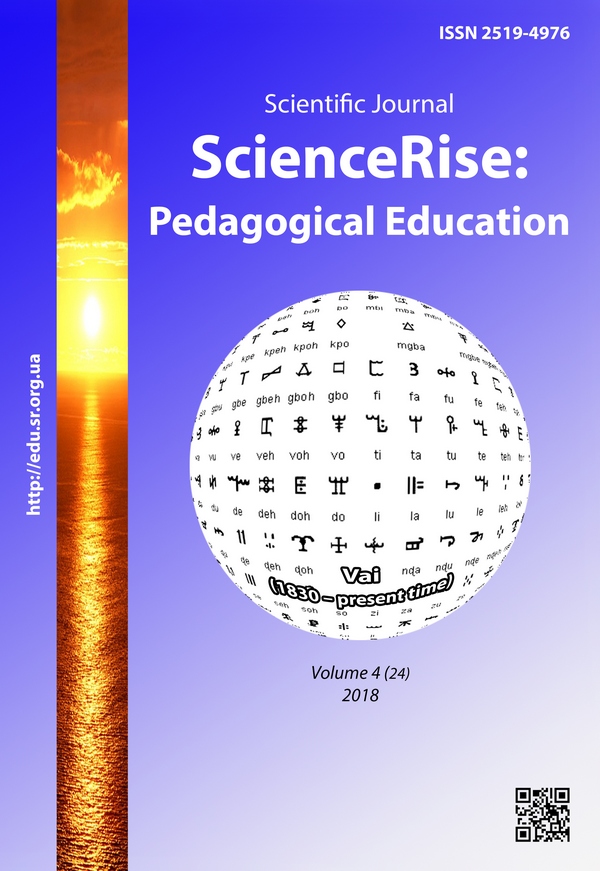Inclusive teaching a foreign language senior pupils with musculoskeletal disorders: special educational needs and adjustments
DOI:
https://doi.org/10.15587/2519-4984.2018.131974Keywords:
inclusion, senior learners, cerebral palsy, musculoskeletal disorder, special educational needsAbstract
According to the legislation existing in Ukraine pupils with special educational needs can study in both – special and mainstream schools or classes. There is a discussion in the society about advantages and disadvantages of inclusion for pupils with severe disabilities. The main point is that transferring those to mainstream schools should be based on proper adjustments and that the decision itself depends on the nature and severity of disability.
The research aims to highlight the adjustments that are to be done to meet special educational needs of senior learners with musculoskeletal disorders caused by cerebral palsy and namely in teaching them a foreign language.
As a result of analysing cerebral palsy types, 3 main barriers for learning a foreign language were identified: a difficulty to stand or walk independently, a difficulty to sit independently and a difficulty to hold objects and to write. The special needs of pupils with musculoskeletal disorder (defined according to the barriers mentioned above) were viewed from the perspective of adjustment types. The latter included the adjustment of: school environment, the Individual Development Program and the Individual Plan, teaching approaches and means of teaching.
The significance of individualization and differentiation as core principles of organizing the process of teaching pupils with musculoskeletal disorder a foreign language is highlighted.
The conclusion drawn from the research is that pupils with cerebral palsy in Ukraine can benefit both from inclusive and special educational settings. The first one empowers the development of their social and learning competences. The second one serves as a complex resource (both methodological and human) to facilitate the educational process. Thus both types should be available for reasonable use in every individual case
References
- Pro zagalnu seredniu osvitu: Zakon Ukrainy No. 651-XIV [On General Secondary Education: The Law of Ukraine No. 651-XIV] (1999). Verkhovna Rada Ukrainy. Available at: http://zakon0.rada.gov.ua/laws/show/651-14 Last accessed: 25.01.2018
- Kalambouka, A., Farrell, P., Dyson, A., Kaplan, I. (2007). The impact of placing pupils with special educational needs in mainstream schools on the achievement of their peers. Educational Research, 49 (4), 365–382. doi: 10.1080/00131880701717222
- Hocutt, A. M. (1996). Effectiveness of Special Education: Is Placement the Critical Factor? The Future of Children, 6 (1), 77–102. doi: 10.2307/1602495
- Samsonova, L. (2015). Yak daty vsim ditiam povnotsinnu osvitu [How can we give all children decent education]. Insider. Available at: http://www.theinsider.ua/lifestyle/5578081873c36/ Last accessed: 15.04.2018
- Cole, D. A., Meyer, L. H. (1991). Social Integration and Severe Disabilities: A longitudinal analysis of child outcomes. The Journal of Special Education, 25 (3), 340–351. doi: 10.1177/002246699102500306
- Zotova, А. М. (1997). Integratsia riebionka-invalida v sriedu zdorovykh sviersnikov kak mietod sotsialnoi adaptatsii [The integration of a child with disability into the mainstream environment as a method of their social adaptation]. Defektologia [Defectology], 6, 21–25.
- Jenkinson, J. (2000). All Students Belong: Inclusive Education for Students with Severe Learning Disabilities. Tizard Learning Disability Review, 5 (4), 4–13. doi: 10.1108/13595474200000032
- Shah, S. (2007). Special or mainstream? The views of disabled students. Research Papers in Education, 22 (4), 425–442. doi: 10.1080/02671520701651128
- Warnock, M., Norwich, B.; Terzi, L. (Ed.) (2010). Special educational needs. Key debates in educational policy. London-New York: Bloomsbury, 184.
- Badalian, L. О., Zhurba, L. T., Tymonina, O. V. (1988). Dietskie tserebralnie paralichi [Cerebral palsies]. Kyiv: Zdorovya, 328.
- Kоziavkin, V. І., Babadagly, M. О., Lun, G. P., Kаchmar, О. О., Gordievich, S. М. et al.; Kоziavkin, V. І. (Ed.) (2011). Меtоd Kоziavkina – systema intensyvnoi neirofiziologichnoi reabilitatsii [Koziavkin Method – a system of neurophysiologic rehabilitation]. Lviv: Dyzain-studia "Papuga", 240.
- Shtulman, D. R., Lievin, О. S. (2002). Nievrologia. Spravochnik prakticheskogo vracha [Neurology. A handbook of a practitioner]. Moscow: МЕDpress-inform, 784.
- Grashchenkova, N. I., Sniezhnievskii, А. V. (Eds.) (1969). Spravochnik nievrologa i psikhiatra [A handbook of a neurologist and a psychiatrist]. Moscow: Меditsina, 576.
- Dodatok do lysta МОNmolodsportu No. 1/9-529 vid 26.07.12 "Psykhologichnyi i sotsialnyi suprovid ditei z osoblyvymy potrebamy v umovakh inkluzyvnogo navchannia" [Supplement to the letter by МОNmolodsportu No. 1/9-529 issued 26.07.12 "The psychological and social support of children with special needs in the conditions of inclusive instruction"]. Available at: http://metodist.ucoz.com/news/list_monmolodsport_1_9_529_vid_26_07_12_roku/2012-07-30-931 Last accessed: 13.01.2018
- Reabilitatsiinyi suprovid navchannia nepovnospravnykh ditei [The rehabilitation support of teaching children with disability] (2008). Lviv: Koleso, 144.
- Tomlinson, C. A. (2017). How to Differentiate Instruction in Academically Diverse Classrooms. Alexandria: ASCD, 187.
- Taranchenko, О. M., Naida, Yu. М.; Kolupaieva, A. A. (Ed.) (2012). Dyferentsiyovane vykladannia v inkliuzyvnomu navchalnomu zakladi [Differentiated instruction in inclusive school]. Kyiv: Vydavnycha grupa "А.С.K.", 124.
Downloads
Published
How to Cite
Issue
Section
License
Copyright (c) 2018 Natalia Scherba

This work is licensed under a Creative Commons Attribution 4.0 International License.
Our journal abides by the Creative Commons CC BY copyright rights and permissions for open access journals.
Authors, who are published in this journal, agree to the following conditions:
1. The authors reserve the right to authorship of the work and pass the first publication right of this work to the journal under the terms of a Creative Commons CC BY, which allows others to freely distribute the published research with the obligatory reference to the authors of the original work and the first publication of the work in this journal.
2. The authors have the right to conclude separate supplement agreements that relate to non-exclusive work distribution in the form in which it has been published by the journal (for example, to upload the work to the online storage of the journal or publish it as part of a monograph), provided that the reference to the first publication of the work in this journal is included.








